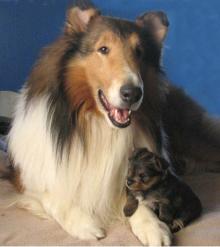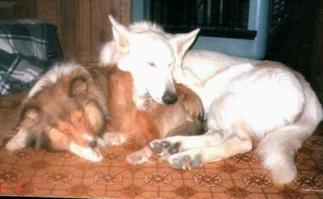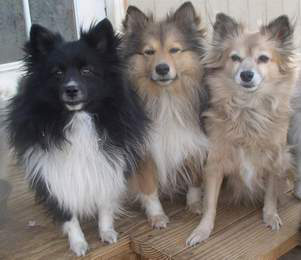Early Spay-Neuter
Considerations for the Canine Athlete
© 2005 Chris Zink DVM, PhD, DACVP
(Reprinted with permission)
Those of us with responsibility for the health of canine athletes
need to continually read and evaluate new scientific studies to
ensure that we are taking the most appropriate care of our
performance dogs. This article provides evidence through a
number of recent studies to suggest that veterinarians and
owners working with canine athletes should revisit the standard
protocol in which all dogs that are not intended for breeding
are
spayed and neutered at or before 6 months of age.
Orthopedic Considerations
A study by Salmeri et al in 1991 found that bitches spayed
at 7 weeks grew significantly taller than those spayed at
7 months, who were taller than those not spayed
(or presumably spayed after the growth plates had closed).
(1) A study of 1444 Golden Retrievers performed in 1998 and
1999 also found bitches and dogs spayed and neutered at less
than a year of age were significantly taller than those spayed
or neutered at more than a year of age. (2) The sex hormones,
by communicating with a number of other growth-related
hormones, promote the closure of the growth plates at puberty
(3), so the bones of dogs or bitches neutered or spayed before
puberty continue to grow. Dogs that have been spayed or
neutered well before puberty can frequently be identified by
their longer limbs, lighter bone structure, narrow chests and
narrow skulls. This abnormal growth frequently results in
significant alterations in body proportions and particularly
the lengths (and therefore weights) of certain bones relative
to others. For example, if the femur has achieved its
genetically determined normal length at 8 months when a dog
gets spayed or neutered, but the tibia, which normally stops
growing at 12 to 14 months of age continues to grow, then an
abnormal angle may develop at the stifle. In addition, with the
extra growth, the lower leg below the stifle likely becomes
heavier (because it is longer), and may cause increased
stresses on the cranial cruciate ligament. In addition, sex
hormones are critical for achieving peak bone density.
(4) These structural and physiological alterations may be the
reason why at least one recent study showed that spayed and
neutered dogs had a higher incidence of CCL rupture.
(5) Another recent study showed that dogs spayed or
neutered before 5 1/2 months had a significantly higher
incidence of hip dysplasia than those spayed or neutered after
5 1/2 months of age, although it should be noted that in this
study there were no standard criteria for the diagnosis of hip
dysplasia. (6) Nonetheless, breeders of purebred dogs should
be cognizant of these studies and should consider whether or
not pups they bred were spayed or neutered when considering
breeding decisions.
Cancer Considerations
A retrospective study of cardiac tumors in dogs showed that
there was a 5 times greater risk of hemangiosarcoma, one
of the three most common cancers in dogs, in spayed bitches
than intact bitches and a 2.4 times greater risk of
hemangiosarcoma in neutered dogs as compared to intact males.
(7) A study of 3218 dogs demonstrated that dogs that were
neutered before a year of age had a significantly increased
chance of developing bone cancer. (8) A separate study
showed that neutered dogs had a two-fold higher risk of
developing bone cancer. (9) Despite the common belief that
neutering dogs helps prevent prostate cancer, at least one
study suggests that neutering provides no benefit. (10) There
certainly is evidence of a slightly increased risk of mammary
cancer in female dogs after one heat cycle, and for increased
risk with each subsequent heat. While about 30 % of mammary
cancers are malignant, as in humans, when caught and surgically
removed early the prognosis is very good. (11) Luckily, canine
athletes are handled frequently and generally receive prompt
veterinary care.
Behavioral Considerations
The study that identified a higher incidence of cranial cruciate
ligament rupture in spayed or neutered dogs also identified an
increased incidence of sexual behaviors in males and females
that were neutered early.(5) Further, the study that identified
a higher incidence of hip dysplasia in dogs neutered or spayed
before 5 1/2 months also showed that early age gonadectomy
was associated with an increased incidence of noise phobias and
undesirable sexual behaviors.(6) A recent report of the
American Kennel Club Canine Health Foundation reported
significantly more behavioral problems in spayed and neutered
bitches and dogs. The most commonly observed behavioral
problem in spayed females was fearful behavior and the most
common problem in males was aggression.(12)
Other Health Considerations
A number of studies have shown that there is an increase in
the incidence of female urinary incontinence in dogs spayed
early (13), although this finding has not been universal.
Certainly there is evidence that ovarian hormones are critical
for maintenance of genital tissue structure and contractility.
(14, 15) Neutering also has been associated with an increased
likelihood of urethral sphincter incontinence in males.(16) This
problem is an inconvenience, and not usually life-threatening,
but nonetheless one that requires the dog to be medicated for
life. A health survey of several thousand Golden Retrievers
showed that spayed or neutered dogs were more likely to
develop hypothyroidism.(2) This study is consistent with the
results of another study in which neutering and spaying was
determined to be the most significant gender-associated risk
factor for development of hypothyroidism.(17)
Infectious diseases were more common in dogs that were
spayed or neutered at 24 weeks or less as opposed to those
undergoing gonadectomy at more than 24 weeks.(18) Finally,
the AKC-CHF report demonstrated a higher incidence of
adverse reactions to vaccines in neutered dogs as compared
to intact.(12)
I have gathered these studies to show that our practice of routinely spaying or neutering every dog at or before the age
of 6 months is not a black-and-white issue. Clearly more studies need to be done to evaluate the effects of prepubertal spaying and neutering, particularly in canine athletes.
Currently, I have significant concerns with spaying or neutering
canine athletes before puberty. But of course, there is the pet
overpopulation problem. How can we prevent the production of
unwanted dogs while still leaving the gonads to produce the
hormones that are so important to canine growth and development?
One answer would be to perform vasectomies in males and tubal ligation in females, to be followed after maturity by
ovariohysterectomy in females to prevent mammary cancer and pyometra. One possible disadvantage is that vasectomy does not prevent some unwanted behaviors associated with males such as marking and humping. On the other hand, females and neutered males frequently participate in these behaviors too. Really, training is the best solution for these issues. Another possible disadvantage is finding a veterinarian
who is experienced in performing these procedures. Nonetheless, some do, and if the procedures were in
greater demand, more veterinarians would learn them.
I believe it is important that we assess each situation individually. For canine athletes, I currently recommend that dogs and bitches be spayed or neutered after 14 months of age.
References:
Salmeri KR, Bloomberg MS, Scruggs SL, Shille V..
Gonadectomy in immature dogs: effects on skeletal, physical,
and behavioral development. JAVMA 1991;198:1193-1203
http://www.grca.org/healthsurvey.pdf
Grumbach MM. Estrogen, bone, growth and sex: a sea change in conventional wisdom.
J Pediatr Endocrinol Metab. 2000;13
Suppl 6:1439-55.
Gilsanz V, Roe TF, Gibbens DT, Schulz EE, Carlson ME,
Gonzalez O, Boechat MI.
Effect of sex steroids on peak bone density of growing
rabbits. Am J Physiol.
1988 Oct;255(4 Pt 1):E416-21.
Slauterbeck JR, Pankratz K, Xu KT, Bozeman SC,
Hardy DM.
Canine ovariohysterectomy and orchiectomy increases
the prevalence of ACL injury. Clin Orthop Relat Res.
2004 Dec;(429):301-5.
Spain CV, Scarlett JM, Houpt KA.
Long-term risks and benefits of early-age gonadectomy in dogs. JAVMA 2004;224:380-387.
Ware WA, Hopper DL. Cardiac tumors in dogs: 1982-1995.
J Vet Intern Med 1999 Mar-Apr;13(2):95-103
Cooley DM, Beranek BC, Schlittler DL, Glickman NW,
Glickman LT, Waters D, Cancer Epidemiol Biomarkers Prev. 2002 Nov;11(11):1434-40 Ru G, Terracini B, Glickman LT. Host related risk factors for canine osteosarcoma. Vet J.
1998 Jul;156(1):31-9. Obradovich J, Walshaw R, Goullaud E.
The influence of castration on the development of prostatic carcinoma in the dog. 43 cases
(1978-1985). J Vet Intern Med 1987 Oct-Dec;1(4):183-7
http://www.akcchf.org/pdfs/whitepapers/
Biennial_National_Parent_Club_Canine_Health_Conference.
pdf
Meuten DJ. Tumors in Domestic Animals.
4th Edn. Iowa State Press, Blackwell Publishing Company,
Ames, Iowa, p. 575 Stocklin-Gautschi NM, Hassig M,
Reichler IM, Hubler M, Arnold S.
The relationship of urinary incontinence to early spaying in bitches.
J. Reprod. Fertil. Suppl. 57:233-6, 2001 Pessina MA,
Hoyt RF Jr, Goldstein I, Traish AM. Differential effects of
estradiol, progesterone, and testosterone on vaginal structural
integrity. Endocrinology. 2006 Jan;147(1):61-9.
Kim NN, Min K, Pessina MA, Munarriz R, Goldstein I,
Traish AM. Effects of ovariectomy and steroid hormones on
vaginal smooth muscle contractility. Int J Impot Res. 2004
Feb;16(1):43-50. Aaron A, Eggleton K, Power C, Holt PE.
Urethral sphincter mechanism incompetence in male dogs:
a retrospective analysis of 54 cases. Vet Rec. 139:542-6, 1996
Panciera DL. Hypothyroidism in dogs: 66 cases (1987-1992).
J. Am. Vet. Med. Assoc., 204:761-7 1994
Howe LM, Slater MR, Boothe HW, Hobson HP, Holcom JL,
Spann AC. Long-term outcome of gonadectomy performed at
an early age or traditional age in dogs.
J Am Vet Med Assoc. 2001 Jan 15;218(2):217-21.
The Long-Term Health Effects
of Spay / Neuter in Dogs
March, 2007, by Laura J. Sanborn
(Reprinted with Permission)
INTRODUCTION
Dog owners in America are frequently advised to spay/neuter their dogs for health reasons. A number of health benefits are cited, and dog owners are told that "responsible owners spay/neuter their pets". Yet evidence is rarely cited to support the alleged health benefits. When discussing the health impacts of spay/neuter, the adverse health effects are often not mentioned. At times, some adverse effects are mentioned, but the most severe effects usually are not. This article is an attempt to summarize the long-term
health effects associated with spay/neuter in dogs, both positive and negative, that can be found in the veterinary medical literature. This article will not discuss the impact of spay/neuter on
population control, or the impact of spay/neuter on behavior.
Nearly all of the health effects summarized in this article are findings from retrospective epidemiological studies of dogs, which examine potential associations by looking backwards in time. A few are from prospective research studies, which examine
potential associations by looking forward in time.
SUMMARY
An objective reading of the veterinary medical literature reveals a complex situation with respect to the longterm health impacts of spay/neuter in dogs. The evidence shows that spay/neuter
correlates with both positive AND adverse health effects in dogs.
It also suggests how much we really do not yet understand about this subject.
On balance, it appears that no compelling case can be made for neutering most male dogs, especially immature male dogs, in order to prevent future health problems. The number of health problems associated with neutering may exceed the associated health benefits in most cases. On the positive side, neutering male dogs eliminates the small risk (probably <1%) of dying from testicular cancer; reduces the risk of non-cancerous prostate disorders; reduces the risk of perianal fistulas; may possibly reduce the risk
of diabetes (data inconclusive)
On the negative side, neutering male dogs, if done before
maturity, increases the risk of osteosarcoma (bone cancer) by a factor of 3.8. This is a common cancer in medium/large and larger breeds with a poor prognosis. It also increases the risk of cardiac hemangiosarcoma by a factor of 1.6; this is a common cancer and major cause of death in some breeds. Additionally, it triples the
risk of hypothyroidism; increases the risk of geriatric cognitive impairment; and triples the risk of obesity, a common health problem in dogs, and with it the many associated health problems associated with obesity. Neutering males also quadruples the
small risk (<0.6%) of prostate cancer; doubles the small
risk (<1%) of urinary tract cancers; increases the risk of orthopedic disorders; and increases the risk of adverse reactions to vaccinations. For female dogs, the situation is more complex.
The number of health benefits associated with spaying may
exceed the associated health problems in some (not all) cases.
On balance, whether spaying improves the odds of overall good health or degrades them probably depends on the age of the female dog and the relative risk of various diseases in the different breeds. On the positive side, spaying female dogs if done before 2.5 years of age, greatly reduces the risk of mammary tumors,
the most common malignant tumors in female dogs; nearly eliminates the risk of pyometra, which otherwise would affect
about 23% of intact female dogs (pyometra kills about 1% of intact female dogs); reduces the risk of perianal fistulas; removes the
very small risk (0.5%) from uterine, cervical, and ovarian tumors.
On the negative side, spaying female dogs, if done before
maturity, increases the risk of osteosarcoma by a factor of 3.1;
this is a common cancer in larger breeds with a poor prognosis; increases the risk of splenic hemangiosarcoma by a factor of 2.2 and cardiac hemangiosarcoma by a factor of >5; this is a common cancer and major cause of death in some breeds; triples the risk
of hypothyroidism; increases the risk of obesity by a factor
of 1.6-2,
a common health problem in dogs with many associated health problems; causes urinary "spay incontinence" in 4-20% of female dogs; increases the risk of persistent or recurring urinary tract infections by a factor of 3-4; increases the risk of recessed vulva, vaginal dermatitis, and vaginitis, especially for female dogs
spayed before puberty; doubles the small risk (<1%) of urinary
tract tumors; increases the risk of orthopedic disorders; increases the risk of adverse reactions to vaccinations.
One thing is clear - much of the spay/neuter information that is available to the public is unbalanced and contains claims that are exaggerated or unsupported by evidence. Rather than helping to educate pet owners, much of this has contributed to common misunderstandings about the long-term health impacts of spay/neuter in dogs. The traditional spay/neuter age of six months as well as the modern practice of pediatric spay/neuter appear to predispose dogs to health risks that could otherwise be avoided by waiting until the dog is physically mature, or (perhaps in the case
of many male dogs) foregoing it altogether unless medically necessary. The balance of long-term health risks and benefits of spay/neuter will vary from one dog to the next. Across-the-board recommendations for all pet dogs do not appear to be supportable from findings in the veterinary medical literature.
FINDINGS FROM STUDIES
This section summarizes the diseases or conditions that have
been studied with respect to spay/neuter in dogs.
Complications from Spay/Neuter Surgery
All surgery incurs some risk of complications, including adverse reactions to anesthesia, hemorrhage, inflammation, infection, etc. Complications include only immediate and near term impacts that
are clearly linked to the surgery, not to longer term impacts that
can only be assessed by research studies. At one veterinary teaching hospital where complications were tracked, the rates of intraoperative, postoperative and total complications were 6.3%, 14.1% and 20.6%, respectively as a result of spaying female dogs
1. Other studies found a rate of total complications from spaying
of 17.7%2 and 23%3. A study of Canadian veterinary private practitioners found complication rates of 22% and 19% for spaying female dogs and neutering male dogs, respectively 4. Serious complications such as infections, abscesses, rupture of the
surgical wound, and chewed out sutures were reported at a 1- 4% frequency, with spay and castration surgeries accounting for 90% and 10% of these complications, respectively. 4 The death rate
due to complications from spay/neuter is low, at around 0.1%5.
Prostate Cancer
Much of the spay/neuter information available to the public asserts
that neutering will reduce or eliminate the risk that male dogs develop prostate cancer. This would not be an unreasonable assumption, given that prostate cancer in humans is linked to testosterone. But the evidence in dogs does not support this claim. In fact, the strongest evidence suggests just the opposite. There have been several conflicting epidemiological studies over the years that found either an increased risk or a decreased risk of prostate cancer in neutered dogs. These studies did not utilize control populations, rendering these results at best difficult to interpret. This may partially explain the conflicting results.
More recently, two retrospective studies were conducted that did utilize control populations. One of these studies involved a dog population in Europe 6 and the other involved a dog population in America7. Both studies found that neutered male dogs have a four times higher risk of prostate cancer than intact dogs. Based on their results, the researchers suggest a cause and effect relationship: "this suggests that castration does not initiate the development of prostatic carcinoma in the dog, but does favor tumor progression"6 and also "Our study found that most canine prostate cancers are of ductal/urothelial origin. The relatively low incidence of prostate cancer in intact dogs may suggest that testicular hormones are in fact protective against ductal/urothelial prostatic carcinoma, or may have indirect effects on cancer development by changing the environment in the prostate."7 This needs to be put in perspective. Unlike the situation in humans, prostate cancer is uncommon in dogs. Given an incidence of prostate cancer in dogs of less than 0.6% from necropsy studies8, it is difficult to see that the risk of prostate cancer should factor heavily into most neutering decisions. There is evidence for an increased risk of prostate cancer in at least one breed (Bouviers)6, though very little data so far to guide us in regards to other breeds.
Testicular Cancer
Since the testicles are removed with neutering, castration removes
any risk of testicular cancer (assumingthe castration is done
before cancer develops). This needs to be compared to the risk of testicular cancer in intact dogs. Testicular tumors are not uncommon in older intact dogs, with a reported incidence of 7%9. However, the prognosis for treating testicular tumors is very good owing to a low rate of metastasis, so testicular cancer is an uncommon cause of death in intact dogs. For example, in a
Purdue University breed health survey of Golden Retrievers10, deaths due to testicular cancer were sufficiently infrequent that they did not appear on list of significant causes of "Years of Potential Life Lost for Veterinary confirmed Cause of Death" even though 40% of GR males were intact. Furthermore, the GRs who were treated for testicular tumors had a 90.9% cure rate. This agrees well with other work that found 6-14% rates of metastasis for testicular tumors in dogs 11. The high cure rate of testicular tumors combined with their frequency suggests that fewer
than 1% of intact male dogs will die of testicular cancer. In summary, though it may be the most common reason why many advocate
neutering young male dogs, the risk from life threatening testicular
cancer is sufficiently low that neutering most male dogs to prevent
it is difficult to justify. An exception might be bilateral or unilateral
cryptorchids, as testicles that are retained in the abdomen are
13.6 times more likely to develop tumors than descended
testicles 12 and it is also more difficult to detect retained tumors
by routine physical examination.
Osteosarcoma (Bone Cancer)
A multi-breed case-control study of the risk factors for
osteosarcoma found that spay/neutered dogs (males or females)
had twice the risk of developing osteosarcoma as did intact dogs13. This risk was further studied in Rottweilers, a breed with a
relatively high risk of osteosarcoma. This retrospective cohort
study broke the risk down by age at spay/neuter, and found that
the elevated risk of osteosarcoma is associated with spay/neuter
of young dogs14. Rottweilers spayed/neutered before one year of
age were 3.8 (males) or 3.1 (females) times more likely to develop
osteosarcoma than intact dogs. Indeed, the combination of breed
risk and early spay/neuter meant that Rottweilers spayed/
neutered before one year of age had a 28.4% (males) and 25.1%
(females) risk of developing osteosarcoma. These results are
consistent with the earlier multi-breed study13 but have an
advantage of assessing risk as a function of age at neuter. The
researchers suggest a cause-and-effect relationship, as sex
hormones are known to influence themaintenance of skeletal
structure and mass, and also because their findings showed an
inverse relationship between time of exposure to sex hormones
and risk of osteosarcoma.14 The risk of osteosarcoma increases
with increasing breed size and especially height13. It is a common
cause of death in medium/large, large, and giant breeds.
Osteosarcoma is the third most common cause of death in
Golden Retrievers10 and is even more common in larger
breeds13.
Given the poor prognosis of osteosarcoma and its frequency in
many breeds, spay/neuter of immature dogs in the medium/large,
large, and giant breeds is apparently associated with a
significant and elevated risk of death due to osteosarcoma.
Mammary Cancer (Breast Cancer)
Mammary tumors are by far the most common tumors in intact
female dogs, constituting some 53% of all malignant tumors in
female dogs in a study of dogs in Norway15 where spaying is
much less common than in the USA. 50-60% of mammary
tumors are malignant, for which there is a significant risk of metastasis16. Mammary tumors in dogs have been found to have estrogen receptors17, and the published research18 shows that the relative risk (odds ratio) that females will develop mammary cancer compared to the risk in intact females is dependent on how many estrus cycles she experiences: # of estrus cycles before
spay Odds Ratio: None - 0.005; 1 - 0.08; 2 or more - 0.26:
Intact 1.00. The same data when categorized differently showed
that the relative risk (odds ratio) that females will develop
mammary cancer compared to the risk in intact females is
indicated that: Age at Spaying Odds Ratio: 29 months - 0.06;
30 months - 0.40 (not statistically significant at the P<0.05 level)
Intact - 1.00. Please note that these are RELATIVE risks. This
study has been referenced elsewhere many times but the results
have often been misrepresented as absolute risks. A similar
reduction in breast cancer risk was found for women under the
age of 40 who lost their estrogen production due to "artificial
menopause"19 and breast cancer in humans is known to be
estrogen activated. Mammary cancer was found to be the 10th
most common cause of years of lost life in Golden Retrievers,
even though 86% of female GRs were spayed, at a median age
of 3.4 yrs10. Considering that the female subset accounts for
almost all mammary cancer cases, it probably would rank at
about the 5th most common cause of years of lost life in female
GRs. It would rank higher still if more female GRs had been
kept intact up to 30 months of age. Boxers, cocker spaniels,
English springer spaniels, and dachshunds are breeds at high
risk of mammary tumors15. A population of mostly intact
female Boxers was found to have a 40% chance of developing
mammary cancer between the ages of 6-12 years of age15.
Purebred dogs are at higher risk than mixed breed dogs, and
purebred dogs with high inbreeding coefficients are at higher risk
than those with low inbreeding coefficients.20. In summary,
spaying female dogs significantly reduces the risk of mammary
cancer (a common cancer), and the fewer estrus cycles
experienced at least up to 30 months of age, the lower the risk
will be.
Reproductive Tract Cancer (Uterine, Cervical,
and Ovarian Cancers)
Uterine/cervical tumors are rare in dogs, constituting just 0.3%
of tumors in dogs 21. Spaying will remove the risk of ovarian
tumors, but the risk is only 0.5%22. While spaying will remove
the risk of reproductive tract tumors, it is unlikely that surgery
can be justified to prevent the risks of uterine, cervical, and
ovarian cancers as the risks are so low.
Urinary Tract Cancer (Bladder and Urethra Cancers)
An age-matched retrospective study found that spay/neuter dogs
were two times more likely to develop lower urinary tract tumors
(bladder or urethra) compared to intact dogs23. These tumors are
nearly always malignant, but are infrequent, accounting for less
than 1% of canine tumors. So this risk is unlikely to weigh heavily
on spay/neuter decisions. Airedales, Beagles, and
Scottish Terriers are at elevated risk for urinary tract cancer
while German Shepherds have a lower than average risk23.
Hemangiosarcoma
Hemangiosarcoma is a common cancer in dogs. It is a major
cause of death in some breeds, such as Salukis, French Bulldogs, Irish Water Spaniels, Flat Coated Retrievers, Golden Retrievers, Boxers, Afghan Hounds, English Setter, Scottish Terrier, Boston Terrier, Bulldogs, and German Shepherd Dogs24. In an aged-matched case controlled study, spayed females were found to
have a 2.2 times higher risk of splenic hemangiosarcoma
compared to intact females24. A retrospective study of cardiac hemangiosarcoma risk factors found a >5 times greater risk in spayed female dogs compared to intact female dogs and a 1.6 times higher risk in neutered male dogs compared to intact male dogs.25 The authors suggest a protective effect of sex hormones against hemangiosarcoma, especially in females. In breeds
where hermangiosarcoma is an important cause of death, the increased risk associated with spay/neuter is likely one that
should factor into decisions on whether or when to sterilize a dog.
Hypothyroidism
Spay/neuter in dogs was found to be correlated with a three fold increased risk of hypothyroidism compared to intact dogs.
The researchers suggest a cause-and-effect relationship26. They wrote: "More important [than the mild direct impact on thyroid function] in the association between [spaying and] neutering and hypothyroidism may be the effect of sex hormones on the immune system. Castration increases the severity of autoimmune
thyroiditis in mice" which may explain the link between spay/neuter and hypothyroidism in dogs. Hypothyroidism in dogs causes obesity, lethargy, hair loss, and reproductive abnormalities.27
Obesity
Owing to changes in metabolism, spay/neuter dogs are more likely
to be overweight or obese than intact dogs. One study found a
two fold increased risk of obesity in spayed females compared to intact females 28. Another study found that spay/neuter dogs
were 1.6 (females) or 3.0 (males) times more likely to be obese than intact dogs, and 1.2 (females) or 1.5 (males) times more
likely to be overweight than intact dogs29. A survey study of veterinary practices in the UK found that 21% of dogs were obese.28 Being obese and/or overweight is associated with a
host of health problems in dogs. Overweight dogs are more likely
to be diagnosed with hyperadrenocorticism, ruptured cruciate ligament, hypothyroidism, lower urinary tract disease, and oral disease30. Obese dogs are more likely to be diagnosed with hypothyroidism, diabetes mellitus, pancreatitis, ruptured cruciate ligament, and neoplasia (tumors)30.
Diabetes
Some data indicate that neutering doubles the risk of diabetes in male dogs, but other data showed no significant change in
diabetes risk with neutering 31. In the same studies, no
association was found between spaying and the risk of diabetes.
Adverse Vaccine Reactions
A retrospective cohort study of adverse vaccine reactions in dogs
was conducted, which included allergic reactions, hives, anaphylaxis, cardiac arrest, cardiovascular shock, and sudden death. Adverse reactions were 30% more likely in spayed females than intact females, and 27% more likely in neutered males than intact males 32. The investigators discuss possible cause-and-effect mechanisms for this finding, including the roles that sex hormones play in body's ability to mount an immune response to
vaccination.32. Toy breeds and smaller breeds are at elevated
risk of adverse vaccine reactions, as are Boxers, English Bulldogs,
Lhasa Apsos, Weimaraners, American Eskimo Dogs, Golden Retrievers, Basset Hounds, Welsh Corgis, Siberian Huskies, Great Danes, Labrador Retrievers, Doberman Pinchers,
American Pit Bull Terriers, and Akitas.32 Mixed breed dogs were found to be at lower risk, and the authors suggest genetic
hetereogeneity (hybrid vigor) as the cause.
Urogenital Disorders
Urinary incontinence is common in spayed female dogs, which can occur soon after spay surgery or after a delay of up to several years. The incidence rate in various studies is 4-20% 33,34,35 for spayed females compared to only 0.3% in intact females36.
Urinary incontinence is so strongly linked to spaying that it is commonly called "spay incontinence" and is caused by urethral sphincter incompetence37, though the biological mechanism is unknown. Most (but not all) cases of urinary incontinence respond to medical treatment, and in many cases this treatment needs to
be continued for the duration of the dog's life.38. A retrospective study found that persistent or recurring urinary tract (bladder) infections (UTIs) were 3-4 times more likely in spayed females dogs than in intact females39. Another retrospective study found that female dogs spayed before 5 ½ months of age were 2.76
times more likely to develop UTIs compared to those spayed
after 5 ½ months of age.40 Depending on the age of surgery, spaying causes abnormal development of the external genitalia. Spayed females were found to have an increased risk of recessed vulva, vaginal dermatitis, vaginitis, and UTIs.41 The risk is higher still for female dogs spayed before puberty.41
Pyometra (Infection of the Uterus)
Pet insurance data in Sweden (where spaying is very uncommon) found that 23% of all female dogs developed pyometra before 10 years of age42. Bernese Mountain dogs, Rottweilers,
RoughCollies, Cavalier King Charles Spaniels and Golden Retrievers were found to be high risk breeds 42. Female dogs
that have not whelped puppies are at elevated risk for pyometra 43. Rarely, spayed female dogs can develop "stump pyometra" related to incomplete removal of the uterus. Pyometra can usually be treated surgically or medically, but 4% of pyometra cases led to death 42. Combined with the incidence of pyometra, this suggests that about 1% of intact female dogs will die from pyometra.
Perianal Fistulas
Male dogs are twice as likely to develop perianal fistulas as
females, and spay/neutered dogs have a decreased risk
compared to intact dogs44. German Shepherd Dogs and Irish Setters are more likely to develop perianal fistulas than are other breeds.44
Non-cancerous Disorders of the Prostate Gland
The incidence of benign prostatic hypertrophy (BPH, enlarged
prostate) increases with age in intact male dogs, and occurs in
more than 80% of intact male dogs older than the age of
5 years45. Most cases of BPH cause no problems, but in some
cases the dog will have difficulty defecating or urinating.
Neutering will prevent BPH. If neutering is done after the
prostate has become enlarged, the enlargedprostate will shrink
relatively quickly. BPH is linked to other problems of the prostate
gland, including infections, abscesses, and cysts, which can
sometimes have serious consequences.
Orthopedic Disorders
In a study of beagles, surgical removal of the ovaries (as happens
in spaying) caused an increase in the rate of remodeling of the
ilium (pelvic bone)46, suggesting an increased risk of hip
dysplasia with spaying. Spaying was also found to cause a net
loss of bone mass in the spine 47. Spay/neuter of immature dogs
delays the closure of the growth plates in bones that are still
growing, causing those bones to end up significantly longer than
in intact dogs or those spay/neutered after maturity48. Since the
growth plates in various bones close at different times,
spay/neuter that is done after some growth plates have closed but
before other growth plates have closed can result in a dog with
unnatural proportions, possibly impacting performance and long
term durability of the joints. Spay/neuter is associated with a two
fold increased risk of cranial cruciate ligament rupture49. Perhaps
this is associated with the increased risk of obesity28 or to
changes in body proportions in dogs spay/neutered before the growth plates in the bones have closed 48. Spay/neuter before
5 ½ months of age is associated with a 70% increased
aged-adjusted risk of hip dysplasia compared to dogs spayed/neutered after 5 ½ months of age40. The researchers suggest "it is possible that the increase in bone length that results from early-age gonadectomy results in changes in joint conformation, which could lead to a diagnosis of hip dysplasia".
In a breed health survey study of Airedales, spay/neuter dogs
were significantly more likely to suffer hip dysplasia as well as "any musculoskeletal disorder", compared to intact dogs50, however possible confounding factors were not controlled for, such as the
possibility that some dogs might have been spayed/neutered
because they had hip dysplasia or other musculoskeletal
disorders. Compared to intact dogs, another study found that
dogs neutered six months prior to a diagnosis of hip dysplasia
were 1.5 times as likely to develop clinical hip dysplasia.51
Geriatric Cognitive Impairment
Neutered male dogs and spayed female dogs are at increased risk
of geriatric cognitive impairment compared to intact male dogs52.
There weren't enough intact geriatric females available for the
study to determine their risk. Geriatric cognitive impairment
includes disorientation in the house or outdoors, changes in social
interactions with human family members, loss of house training,
and changes in the sleep-wake cycle52. The investigators state
"This finding is in line with current research on the
neuro-protective roles of testosterone and estrogen at the cellular
level and the role of estrogen in preventing Alzheimer's disease in
human females. One would predict that estrogens would have a
similar protective role in the sexually intact female dogs;
unfortunately too few sexually intact female dogs were available
for inclusion in the present study to test the hypothesis"52
CONCLUSIONS
An objective reading of the veterinary medical literature reveals a
complex situation with respect to the longterm health impacts of
spay/neuter in dogs. The evidence shows that spay/neuter
correlates with both positive AND adverse health effects in dogs.
It also suggests how much we really do not yet understand about
this subject. On balance, it appears that no compelling case can be made for neutering most male dogs to prevent future health
problems, especially immature male dogs. The number of health
problems associated with neutering may exceed the associated
health benefits in most cases. For female dogs, the situation is
more complex. The number of health benefits associated with
spaying may exceed the associated health problems in many
(not all) cases. On balance, whether spaying improves the odds
of overall good health or degrades them probably depends on
the age of the dog and the relative risk of various diseases in the
different breeds.
The traditional spay/neuter age of six months as well as the
modern practice of pediatric spay/neuter appear to predispose
dogs to health risks that could otherwise be avoided by waiting
until the dog is physically mature, or (perhaps in the case of many
male dogs) foregoing it altogether unless medically necessary.
The balance of long-term health risks and benefits of spay/neuter
will vary from one dog to the next. Across-the-board
recommendations for all dogs do not appear to be supportable
from findings in the veterinary medical literature.
REFERENCES
1 Burrow R, Batchelor D, Cripps P. Complications observed during
and after ovariohysterectomy of 142 bitches at a veterinary
teaching hospital.Vet Rec. 2005 Dec 24-31;157(26):829-33.
2 Pollari FL, Bonnett BN, Bamsey, SC, Meek, AH, Allen, DG
(1996)
Postoperative complications of elective surgeries in dogs and
cats determined by examining electronic and medical records.
Journal of the American Veterinary Medical Association
208, 1882-1886
3 Dorn AS, Swist RA. (1977) Complications of canine
ovariohysterectomy.
Journal of the American Animal Hospital Association
13, 720-724
4 Can Vet J. 1996 November; 37(11): 672-678. Evaluation of
postoperative complications following elective surgeries of dogs
and cats at private practices using computer records, Pollari FL,
Bonnett BN
5 Pollari FL, Bonnett BN, Bamsey SC, Meek AH, Allen DG.
Postoperative complications of elective surgeries in dogs and
cats determined by examining electronic and paper medical
records. J Am Vet Med Assoc. 1996 Jun 1;208(11):1882-6
6 Teske E, Naan EC, van Dijk EM, van Garderen E, Schalken JA.
Canine prostate carcinoma:
epidemiological evidence of an increased risk in castrated dogs.
Mol Cell Endocrinol. 2002 Nov 29;197(1-2):251-5.
7 Sorenmo KU, Goldschmidt M, Shofer F,
Ferrocone J. Immunohistochemical characterization of canine
prostatic carcinoma and correlation with castration status and
castration time. Vet Comparative Oncology.
2003 Mar; 1 (1): 48
8 Weaver, AD. Vet Rec. 1981; 109, 71-75.
9 Cohen D, Reif JS, Brodey RS, et al: Epidemiological analysis
of the most prevalent sites and types of canine neoplasia
observed in a veterinary hospital. Cancer Res 34:2859-2868,
1974
11 Handbook of Small Animal Practice, 3rd ed
12 Hayes HM Jr, Pendergrass TW. Canine testicular tumors:
epidemiologic features of 410 dogs. Int J Cancer 1976
Oct 15;18(4):482-7
13 Ru G, Terracini B, Glickman LT. Vet J 1998 Jul; 156(1):31-9
14 Cooley DM, Beranek BC, Schlittler DL, Glickman NW,
Glickman LT, Waters DJ. Endogenous gonadal
hormone exposure and bone sarcoma risk.
Cancer Epidemiol Biomarkers Prev. 2002 Nov;11(11):1434-40.
15 Moe L. Population-based incidence of mammary tumours in
some dog breeds. J of Reproduction andFertility Supplment
57, 439-443.
16 Ferguson HR; Vet Clinics of N Amer: Small Animal Practice;
Vol 15, No 3, May 1985
17 MacEwen EG, Patnaik AK, Harvey HJ Estrogen receptors in
canine mammary tumors. Cancer Res., 42: 2255-2259, 1982.
18 Schneider, R, Dorn, CR, Taylor, DON, J Natl Cancer Institute,
Vol 43, No 6, Dec. 1969
19 Feinleib M: Breast cancer and artificial menopause:
A cohort study. J Nat Cancer Inst 41: 315-329, 1968.
20 Dorn CR and Schneider R. Inbreeding and canine mammary
cancer. A retrospective study. J Natl Cancer
Inst. 57: 545-548, 1976.
21 Brodey RS: Canine and feline neoplasia.
Adv Vet Sci Comp Med
14:309-354, 1970
22 Hayes A, Harvey H J: Treatment of metastatic granulosa
cell tumor in a dog. J Am Vet Med Assoc174:1304-1306, 1979
23 Norris AM, Laing EJ, Valli VE, Withrow SJ. J Vet Intern Med
1992 May; 6(3):145-53
24 Prymak C, McKee LJ, Goldschmidt MH,
Glickman LT. J Am Vet Med Assoc 1988 Sep; 193(6):706-12
25 Ware WA, Hopper, DL. Cardiac Tumors inDogs: 1982-1995.
J Vet Intern Med 1999;13:95-103.
26 Panciera DL. J Am Vet Med Assoc. 1994 Mar 1;204(5):761-7
Hypothyroidism in dogs: 66 cases (1987-1992).
27 Panciera DL. Canine hypothyroidism. Part I. Clinical findings
and control of thyroid hormone secretion andmetabolism.
Compend Contin Pract Vet 1990: 12: 689-701.
28 Edney AT, Smith PM. Study of obesity in dogs visiting
veterinary practices in the United Kingdom. .Vet Rec. 1986
Apr 5;118(14):391-6.
29 McGreevy PD, Thomson PC, Pride C, Fawcett A,
Grassi T, Jones B. Prevalence of obesity in dogs examined by
Australian veterinary practices and the risk factors involved.
Vet Rec. 2005 May 28;156(22):695-702.
30 Lund EM, Armstrong PJ, Kirk, CA, Klausner, JS. Prevalence
and Risk Factors for Obesity in Adult Dogs
from Private US Veterinary Practices.
Intern J Appl Res Vet Med . Vol. 4, No. 2, 2006.
31 Marmor M, Willeberg P, Glickman LT, Priester WA,
Cypess RH, Hurvitz AI. Epizootiologic patterns of diabetes
mellitus in dogs Am J Vet Res. 1982 Mar;43(3):465-70. ..
32 Moore GE, Guptill LF, Ward MP, Glickman NW,
Faunt KF, Lewis HB, Glickman LT. Adverse events diagnosed
within three days of vaccine administration in dogs. JAVMA Vol
227, No 7, Oct 1, 2005
33 Thrusfield MV, Holt PE, Muirhead RH. Acquired urinary
incontinence in bitches: its incidence and relationship to
neutering practices.. J Small Anim Pract. 1998.
Dec;39(12):559-66.
34 Stocklin-Gautschi NM, Hassig M, Reichler IM,
Hubler M, Arnold S. The relationship of urinary incontinence to
early spaying in bitches. J Reprod Fertil Suppl. 2001;57:233-6...
35 Arnold S, Arnold P, Hubler M, Casal M, and Rüsch P.
Urinary Incontinence in spayed bitches: prevalence and breed
disposition. European Journal of Campanion Animal Practice.
131, 259-263.
36 Thrusfield MV 1985 Association between urinary incontinence
and spaying in bitches Vet Rec 116 695
37 Richter KP, Ling V. Clinical response and urethral pressure
profile changes after phenypropanolamine in dogs with primary
sphincter incompetence. J Am Vet Med Assoc 1985: 187: 605-611.
38 Holt PE. Urinary incontinence in dogs and cats.
Vet Rec 1990: 127: 347-350.
39 Seguin MA, Vaden SL, Altier C, Stone E, Levine JF (2003)
Persistent Urinary Tract Infections and Reinfections in 100 Dogs
(1989-1999). Journal of Veterinary Internal Medicine:
Vol. 17, No. 5 pp. 622-631.
40 Spain CV, Scarlett JM, Houpt KA. Long-term risks and
benefits of early-age gonadectomy in dogs.
JAVMA 2004;224:380-387.
41 Verstegen-Onclin K, Verstegen J. Non-reproductive
Effects of Spaying and Neutering:
Effects on the Urogenital System
42 Hagman R: New aspects of canine pyometra. Doctoral thesis,
Swedish University of Agricultural Sciences, Uppsala, 2004.
43 Chastain CB, Panciera D, Waters C: Associations between
age, parity, hormonal therapy and breed, and pyometra in
Finnish dogs. Small Anim Endocrinol 1999; 9: 8.
44 Killingsworth CR, Walshaw R, Dunstan RW, Rosser,
EJ. Am J Vet Res, Vol 49, No. 10, Oct 1988.
45 Johnston SD, Kamolpatana K, Root-Kustritz MV,
Johnston GR, Animal Reproductive Science 60-61
(2000) 405-415.
46 Dannuccia GA, Martin RB.,
Patterson-Buckendahl P Ovariectomy and trabecular bone
remodeling in thedog. Calcif Tissue Int 1986; 40: 194-199.
47 Martin RB, Butcher RL, Sherwood L,L Buckendahl P,
Boyd RD, Farris D, Sharkey N, Dannucci G. Effects
of ovariectomy in beagle dogs. Bone 1987; 8:23-31
48 Salmeri KR, Bloomberg MS, Scruggs SL, Shille V.
Gonadectomy in immature dogs: Effects on skeletal, physical,
and behavioral development, JAVMA, Vol 198, No. 7, April 1991.
49 Whitehair JG, Vasseur PB, Willits NH. Epidemiology of
cranial cruciate ligament rupture in dogs. J Am Vet Med Assoc.
1993 Oct 1;203(7):1016-9.
51 van Hagen MA, Ducro BJ, van den Broek J, Knol BW.
Incidence, risk factors, and heritability estimates of hind limb
lameness caused by hip dysplasia in a birth cohort of boxers.
Am J Vet Res. 2005 Feb;66(2):307-12.
52 Hart BL. Effect of gonadectomy on subsequent
development of age-related cognitive impairment in dogs.
J Am Vet Med Assoc. 2001 Jul 1;219(1):51-6.
You're listening to:
"Imagine"
written by John Lennon












 | ||||||
 | ||||||
 | ||||||
 | ||||||
 | ||||||
 | ||||||
 | ||||||
 | ||||||
 | ||||||
 | ||||||
 | ||||||
 | ||||||
 | ||||||